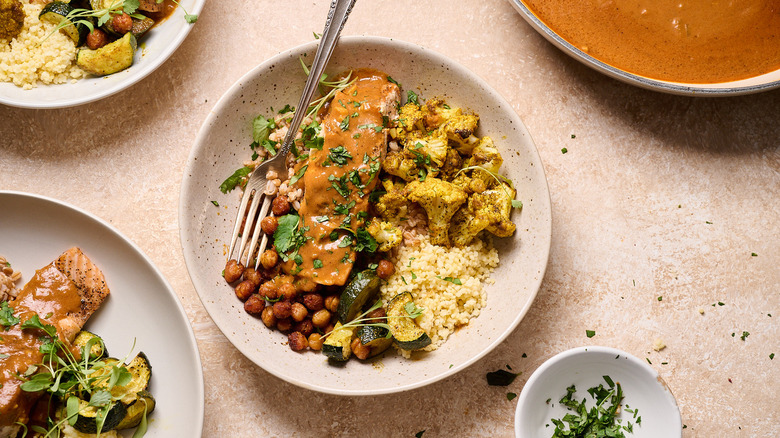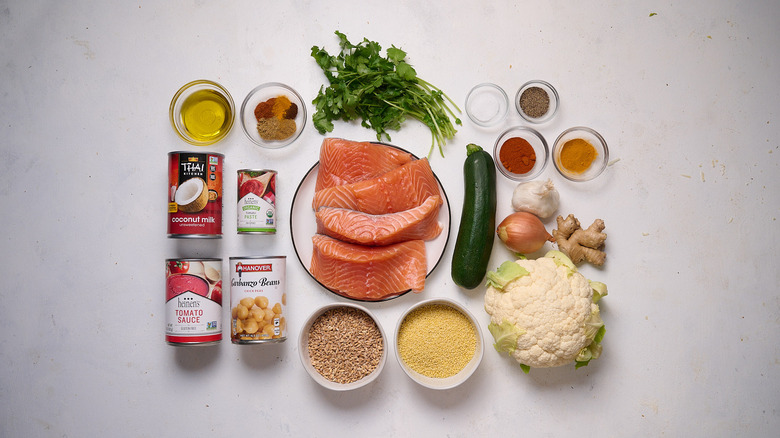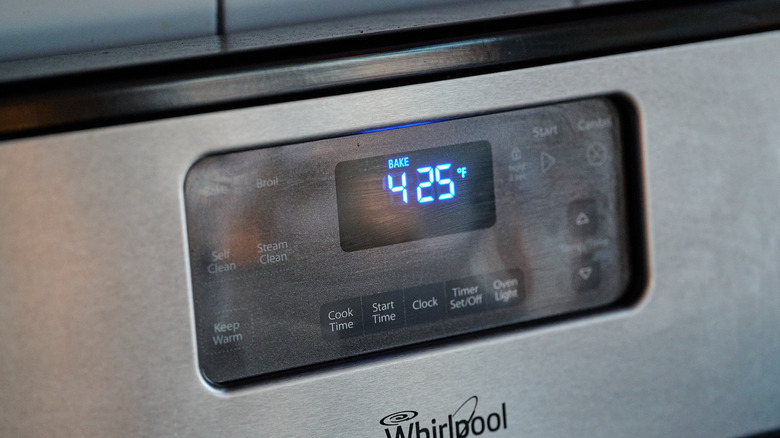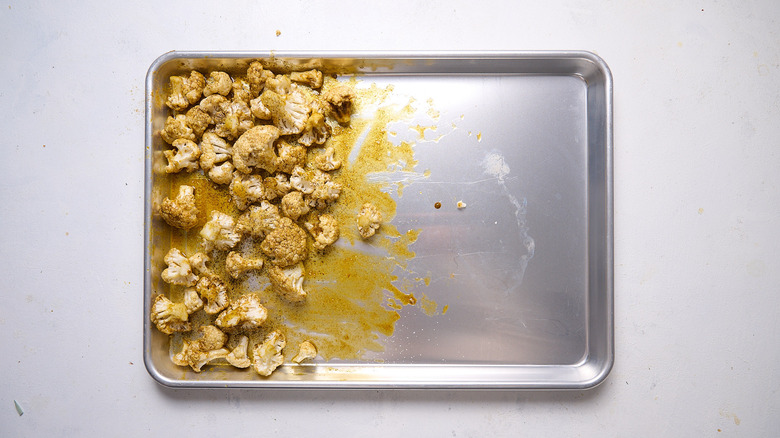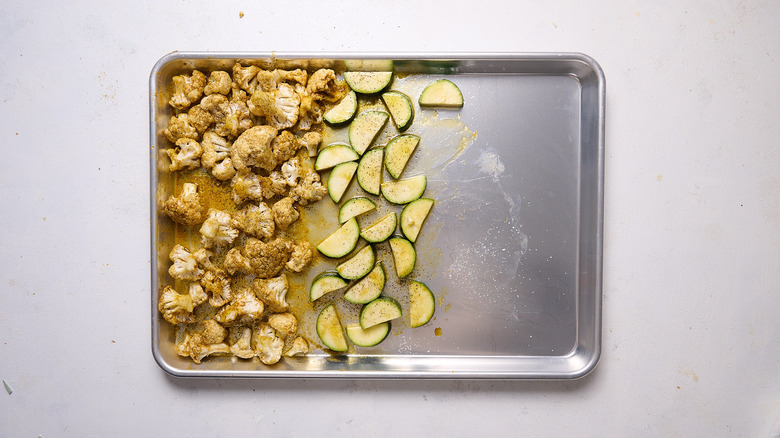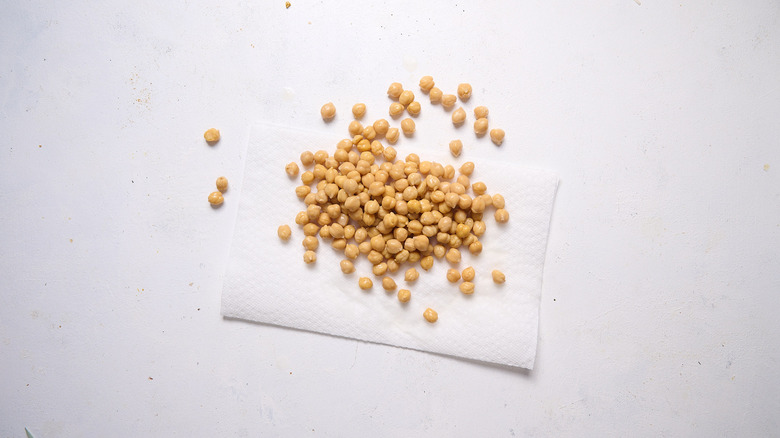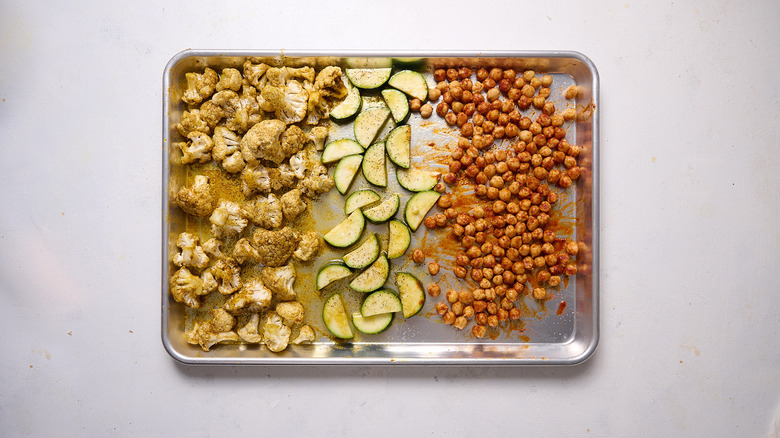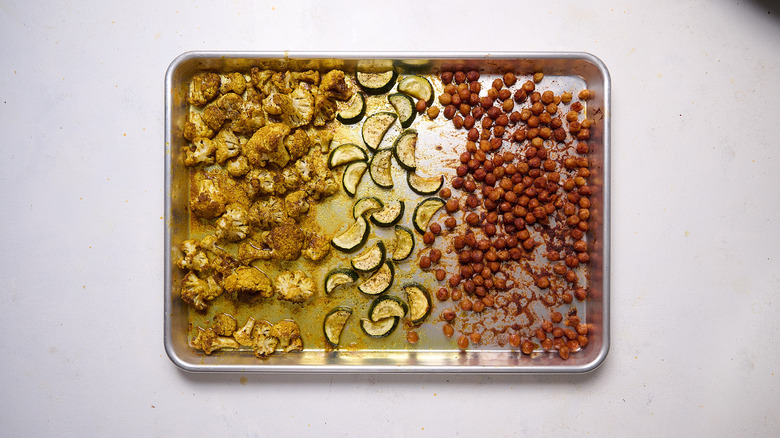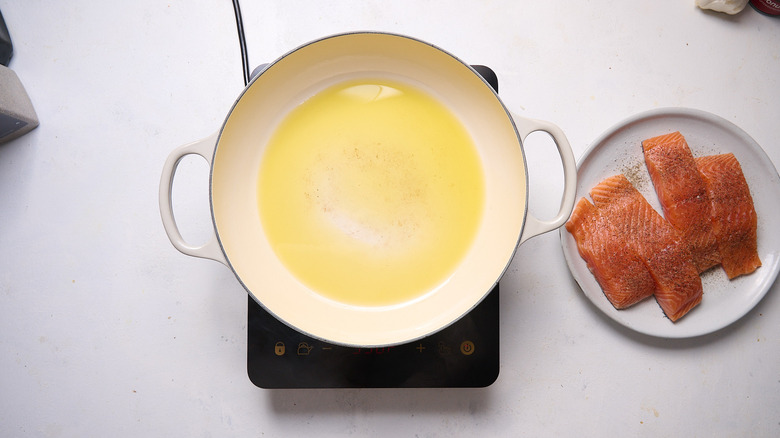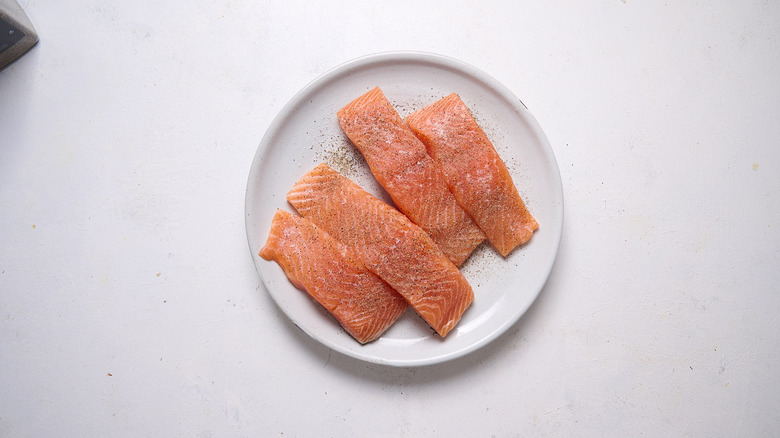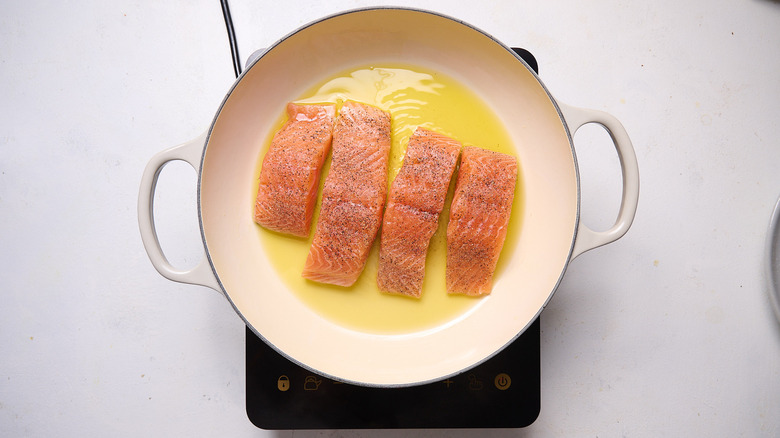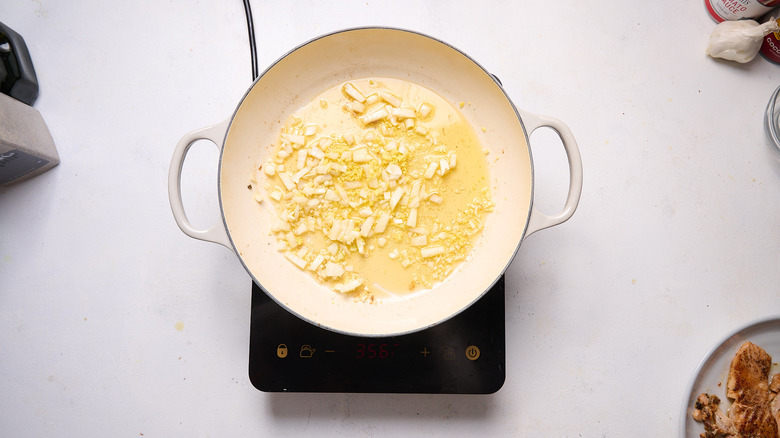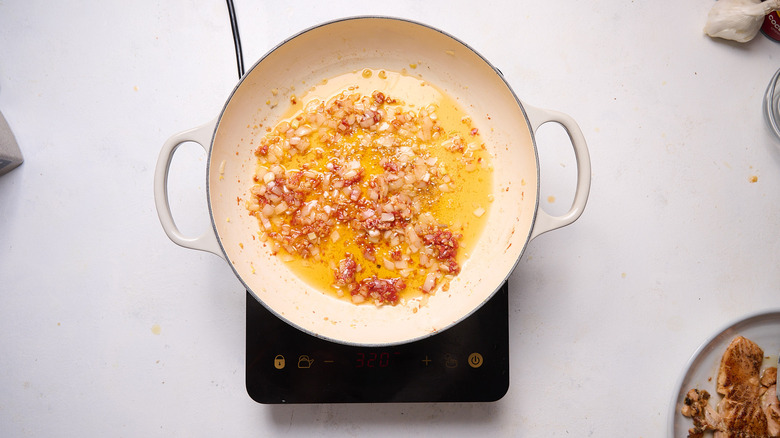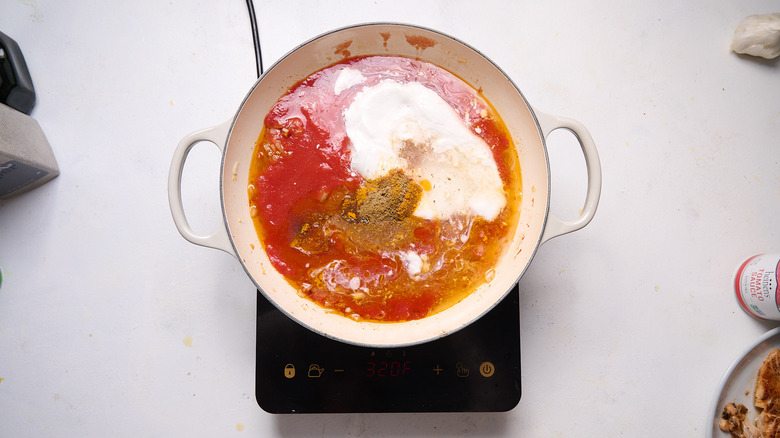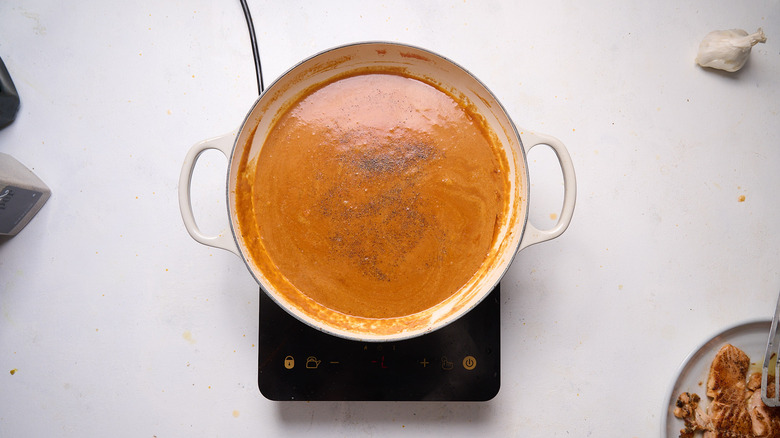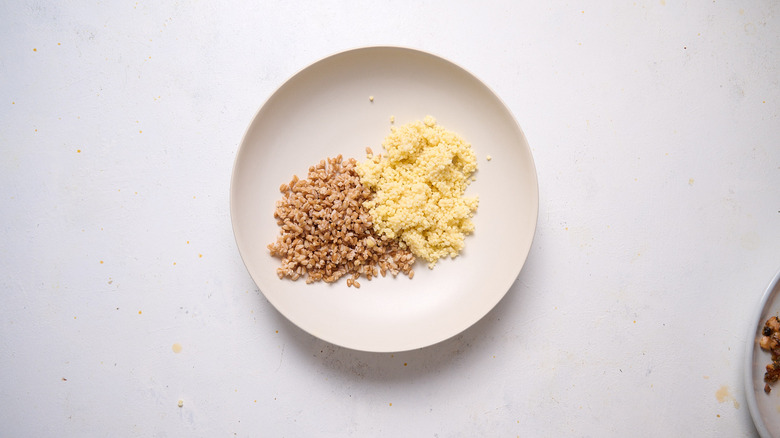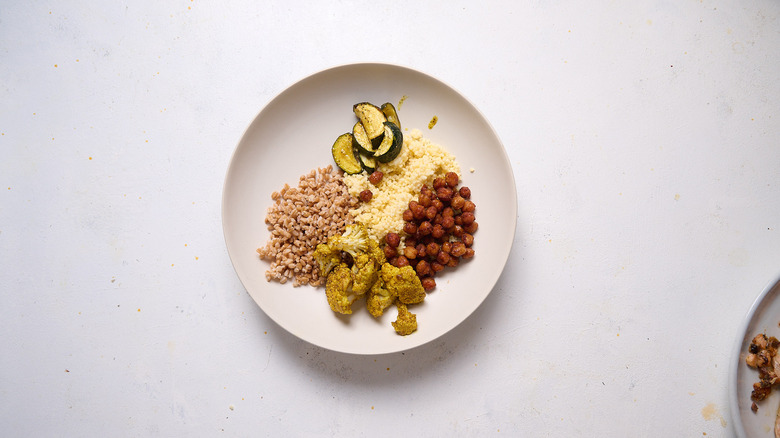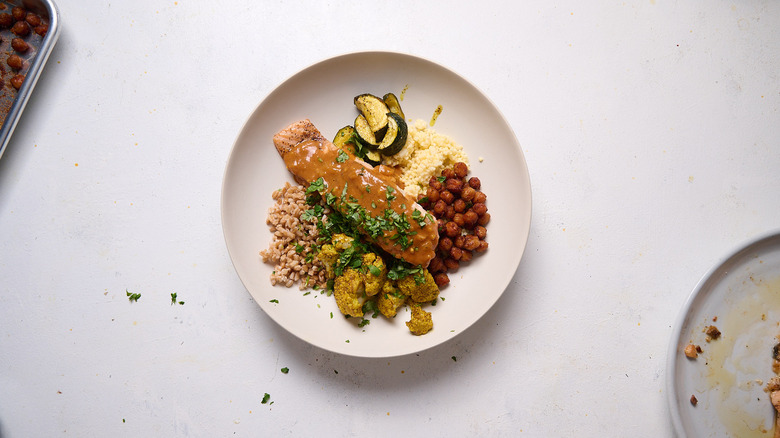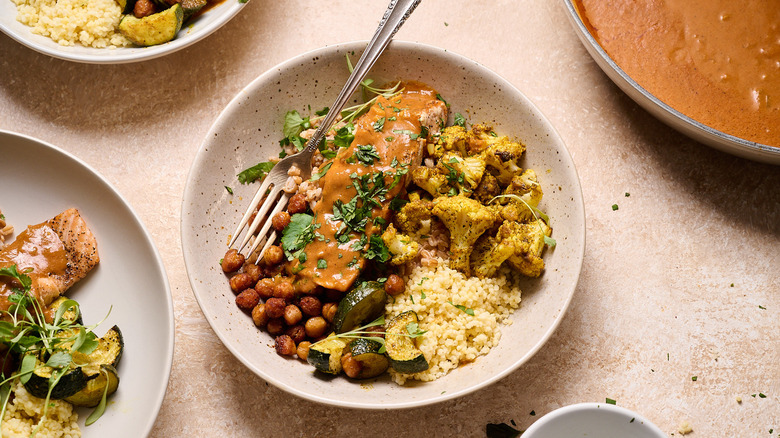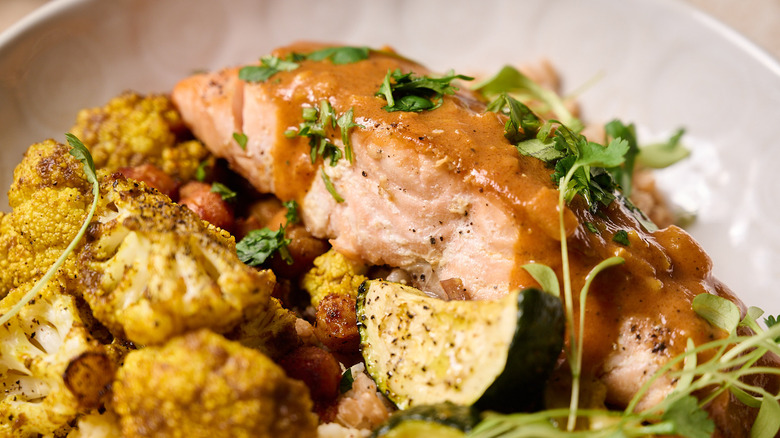Curry Salmon Grain Bowl Recipe
Grain bowls have taken the world by storm, becoming notably more popular in the U.S. since the rise of chains like Chipotle, Qdoba, and Sweetgreen. Likely a result of an increasingly fast-paced, busy society, grain bowls are an easy solution to the decision fatigue that greets us all when it comes time to make dinner at the end of a long weekday. They're more than a salad, but not quite as much effort as a meal with sides, making them the perfect in-between you can't get tired of.
This grain bowl recipe developed with Michelle McGlinn is a spin on tikka masala that transforms the classic Indian dish into a veggie-packed grain bowl. Swapping the chicken for seared salmon, this bowl also features curry-roasted cauliflower, crispy chickpeas, and soft rounds of squash on a bed of farro and pearl millet. Most importantly, the bowl is dressed with a coconut-based masala sauce, giving the bowl a curry-like element with plenty of flavor for a seriously good (and seriously easy) lunch or dinner.
Gather the ingredients for curry salmon grain bowls
For roasting, you'll need a small-to-medium head of cauliflower broken into florets, a large zucchini, and a can of chickpeas. This recipe is made for four servings, but if you want more vegetables, bigger portions, or extra servings, it is easy to scale up or add yellow squash, eggplant, or other vegan options, too. From there, you'll also need olive oil, curry powder, salt, pepper, and paprika — and while you're in the spice cabinet, grab garam masala, turmeric, chili powder, cumin, and ground cloves.
You'll need four fillets of salmon for this recipe, as well as onion, garlic, ginger, tomato paste, tomato sauce, and coconut milk. The grains we recommend for this bowl are farro and pearl millet, which are nutritious and pair well with flaky salmon and roasted veggies, but you can also swap for rice, quinoa, lentils, or couscous.
Step 1: Preheat the oven
Preheat the oven to 425 F.
Step 2: Season the cauliflower
Spread cauliflower florets onto ⅓ of a sheet pan. Toss with 2 tablespoons of olive oil, curry powder, and 1 teaspoon each of salt and pepper.
Step 3: Season the zucchini
Spread the zucchini pieces onto ⅓ of the sheet pan and toss with 1 tablespoon of olive oil and 1 teaspoon each of salt and pepper.
Step 4: Pat the chickpeas dry
Dry the chickpeas and remove any loose skins.
Step 5: Season the chickpeas
Add the chickpeas to the final third of the sheet pan and toss with 1 tablespoon of olive oil, paprika, and 1 teaspoon each of salt and pepper.
Step 6: Roast
Place the sheet pan in the oven and roast until vegetables are tender and chickpeas are crispy, about 20 to 30 minutes.
Step 7: Heat oil in a skillet
In the meantime, heat the remaining 2 tablespoons in a large skillet over medium heat.
Step 8: Season the salmon
Pat the salmon dry and season with the remaining 1 teaspoon each of salt and pepper.
Step 9: Cook the salmon
Add the salmon to the skillet and cook until golden brown on either side, about 8 to 10 minutes.
Step 10: Soften the aromatics
Remove the salmon from the skillet and add oil if needed. Add the garlic, ginger, and onion and stir until soft.
Step 11: Add tomato paste
Stir in the tomato paste and cook until beginning to stick to the bottom of the skillet.
Step 12: Stir in the curry ingredients
Stir in the tomato sauce, coconut milk, and remaining seasonings. Stir and bring to a simmer.
Step 13: Simmer
Simmer until thick, 8 to 10 minutes. Season with salt and pepper to taste.
Step 14: Divide grains into bowls
To serve, divide the farro and millet into bowls.
Step 15: Cover with vegetables
Add the cauliflower, zucchini, and chickpeas to each bowl.
Step 16: Top with salmon and curry sauce
Add the salmon and curry sauce to each bowl and top with cilantro to serve.
How do I store curry salmon grain bowls?
Grain bowls are perfect for meal prepping because they can be stored and reheated while already fully assembled. If you prefer to build each bowl day-of, you can store the salmon, vegetables, sauce, and grains in separate containers and build the bowls individually before heating. However, because everything in the bowl can be heated for about the same amount of time, you can instead store them assembled with grains, vegetables, salmon, and sauce together. This way, you can simply remove a portion from the refrigerator, uncover, and microwave until warmed through.
The grain bowls will last three to five days in the refrigerator, so we recommend prepping less than a week's worth of meals at a time. To freshen up leftovers, add freshly chopped cilantro, fried onion, or mint chutney after reheating. Chutney is a great, easy condiment to pair with salmon curry that balances the deeply spicy flavors of the sauce.
Can I make the salmon in the oven instead?
Since the oven is already heated up and being used for the vegetables, can you use it for the salmon also? Yes, you can, and it's just as easy as using a skillet. Because the salmon and veggies can't roast at the same temperature, you'll need to work in shifts (unless, of course, you have two ovens). We recommend heating the oven to 400 F and throwing the salmon in first because it requires very little prep — just some salt, pepper, and oil. While the salmon is roasting, prepare the vegetables, which need to be chopped, dried, seasoned, and oiled. Once you've prepped the vegetables and the salmon is cooked through, crank the oven up to 425 F and roast the vegetables. Don't worry about the salmon going cold; you can warm it in the oven for a minute or add it directly to the curry sauce to warm through before serving.
Curry Salmon Grain Bowl Recipe
Liven up your lunch or dinner routine with this veggie- and curry salmon-loaded grain bowl recipe.
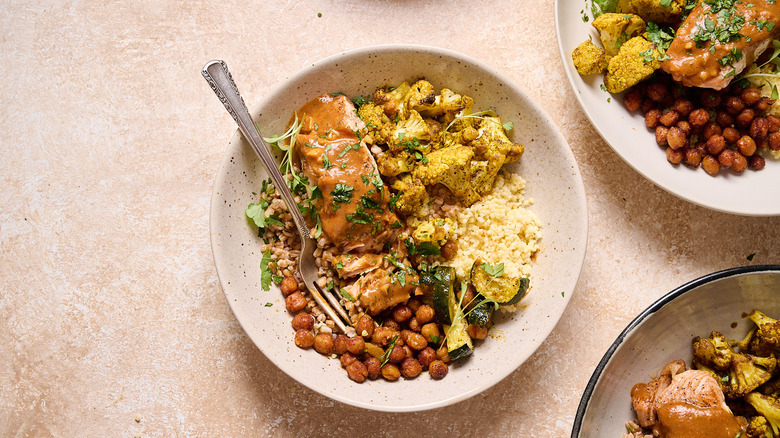
Ingredients
- 1 head cauliflower, cut into florets
- 6 tablespoons olive oil, divided
- 2 tablespoons curry powder
- 4 teaspoons salt, divided, plus more to taste
- 4 teaspoons pepper, divided, plus more to taste
- 1 zucchini, chopped and quartered
- 1 (15.5-ounce) can chickpeas, drained
- 1 teaspoon paprika
- 4 salmon fillets
- 3 cloves garlic, peeled and minced
- 1-inch knob ginger, peeled and minced
- 1 small yellow onion, diced
- 1 tablespoon tomato paste
- 1 (15.5-ounce) can tomato sauce
- 1 (13.6-ounce) can coconut milk
- 1 tablespoon garam masala
- 1 teaspoon turmeric
- 1 teaspoon chili powder
- ½ teaspoon cumin
- ¼ teaspoon ground cloves
- 1 cup millet, cooked
- 1 cup farro, cooked
Optional Ingredients
- Cilantro, for topping
Directions
- Preheat the oven to 425 F.
- Spread cauliflower florets onto ⅓ of a sheet pan. Toss with 2 tablespoons of olive oil, curry powder, and 1 teaspoon each of salt and pepper.
- Spread the zucchini pieces onto ⅓ of the sheet pan and toss with 1 tablespoon of olive oil and 1 teaspoon each of salt and pepper.
- Dry the chickpeas and remove any loose skins.
- Add the chickpeas to the final third of the sheet pan and toss with 1 tablespoon of olive oil, paprika, and 1 teaspoon each of salt and pepper.
- Place the sheet pan in the oven and roast until vegetables are tender and chickpeas are crispy, about 20 to 30 minutes.
- In the meantime, heat the remaining 2 tablespoons in a large skillet over medium heat.
- Pat the salmon dry and season with the remaining 1 teaspoon each of salt and pepper.
- Add the salmon to the skillet and cook until golden brown on either side, about 8 to 10 minutes.
- Remove the salmon from the skillet and add oil if needed. Add the garlic, ginger, and onion and stir until soft.
- Stir in the tomato paste and cook until beginning to stick to the bottom of the skillet.
- Stir in the tomato sauce, coconut milk, and remaining seasonings. Stir and bring to a simmer.
- Simmer until thick, 8 to 10 minutes. Season with salt and pepper to taste.
- To serve, divide the farro and millet into bowls.
- Add the cauliflower, zucchini, and chickpeas to each bowl.
- Add the salmon and curry sauce to each bowl and top with cilantro to serve.
